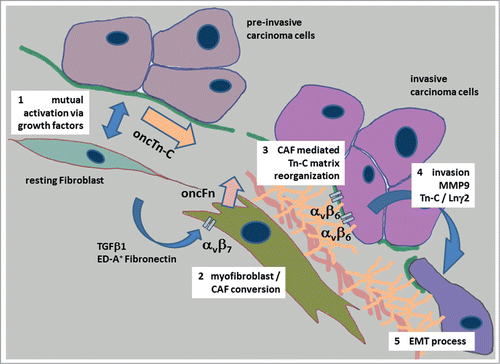Figures & data
Figure 1. Schematic representation of the structure of a single chain of human tenascin-C (TA = Tenascin-C assembly domian, FBG = terminal fibrinogen like globular domain).

Figure 2. Tn-C and its proposed role during invasion and epithelial to mesenchymal transition of carcinoma cells in oral cancer. The process of the development of an invasive carcinoma cell phenotype starts with the mutual activation of stromal and cancer cells, followed by an increased synthesis and secretion of oncofetal Tn-C variants (oncTn-C) by carcinoma cells and stromal fibroblasts (1) This process is accompanied by growth factor mediated fibro-/myofibroblast phenotype transition co-activated by an autocrine ED-A+ fibronectin signaling via αvβ7 integrin Citation82,83 (2). Activated myofibroblasts / cancer associated fibroblasts (CAF´s) produce oncofetal fibronectin variants (oncFn) and reorganize the oncTn-C / oncFn matrix together with other adhesion proteins like Laminins in a provisional manner (3). This provisional matrix mediates invasive phenotype conversion of cancer cells via β6 integrin signaling associated with up regulation of for instance MMP9, Tn-C itself and the migration promoting laminin γ2 chain (Lnγ2) (4). Finally, the carcinoma cells develop an epithelial to mesenchymal transition (EMT) phenotype (5).

